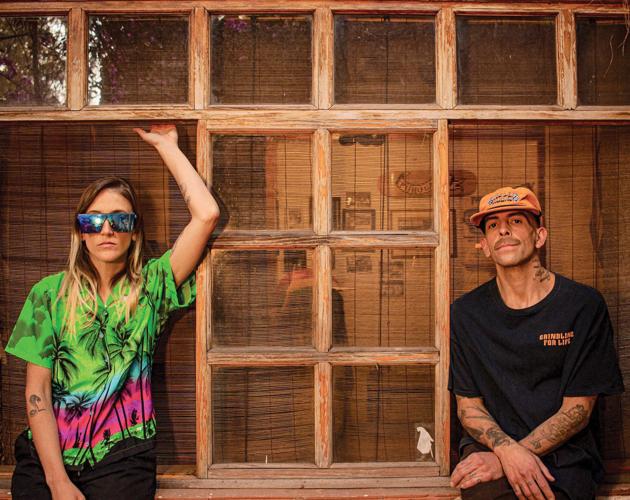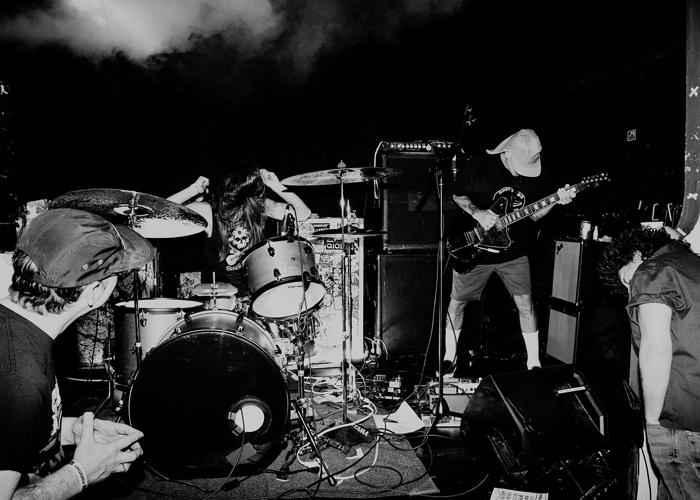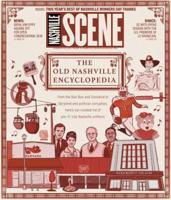
Cardiel
John Cardiel is one of the most intense skateboarders to ever live. Known for his reckless abandon and seemingly limitless velocity, Cardiel was one of the most beloved — and often most bashed-up — faces of the Anti-Hero Skateboards team in the 1990s. In his prime, he was known for fearlessly attacking any surface a skateboard could roll, slide or sail over, be it concrete, metal or otherwise.
“In Venezuela, when we were skating and there’s a big gap or something, and you have to go fast, you say, like: ‘Cardiel! I go Cardiel!’” guitarist and skateboarder Miguel Fraino tells me, grinning broadly on our video call. “This was way before I decided the name of the band.”
Fraino is half of the Mexico City duo Cardiel, a band he formed with his fellow Venezuelan native Samantha Ambrosio. Along with their musical project, Ambrosio and Fraino share a deep love of skate culture that overlaps with their band’s lyrics, aesthetics and attitude. John Cardiel is a particular inspiration for the pair. Like many of his peers, the pro skater has an allegiance to the metal and punk underground. But John Cardiel is also a collector of rare reggae singles, playing his favorite Jamaican deep cuts under his alias DJ Juan Love.
“He has on the [skate] videos Barrington Levy and then Black Sabbath,” Fraino says of his band’s namesake. “He had both kinds of music on the same level.”
The skate-rock twosome developed their sound by drawing from a lot of the same music that drove John Cardiel in his heyday (and does to this day). On the duo’s records, you’ll find moments reminiscent of King Tubby’s smoldering dub reggae, the distorted dirge of Sleep and the barbaric thrash of Bl’ast all coexisting within the same songs, forming a musical concoction that is simultaneously abrasive and inviting.
“It’s kind of hard to explain sometimes when people ask you what kind of music you play,” Ambrosio tells me. “It’s kind of heavy. And then we kind of play some dub and reggae. And everybody’s like, ‘What? That’s a weird mix. I don’t know what’s going on.’” But like a skater connecting various tricks in one jaw-dropping line, Cardiel has a way of transitioning between all their ideas beautifully, as if these disjointed sounds were just waiting to be connected by players who give themselves permission to explore. “It’s really fun to us,” she continues, “but [it’s also] a way to say, ‘Yes, you can do that.’”

Cardiel
Both members of Cardiel are also audio engineers, offering the band plenty of recording time to develop their expansive sound.
“We have a recording studio in Mexico,” Ambrosio says. “All the albums we have made or recorded so far, it’s been between the two of us. When I’m recording the drums,” she says, gesturing toward Fraino, “he’s on the computer hitting ‘record.’”
“And when I was on the guitar, then she was recording,” Fraino explains. “We’re trying to get the elements that we use in a live show on the record.”
The weight of Cardiel’s records — not to mention their live sets — comes from carefully considered musical ideas. Much of the fullness comes from the collection of effects pedals at Fraino’s feet. The pedal board, which Ambrosio refers to as the band’s third member, is the secret piece that gives Cardiel so much texture. The guitarist notes that he’s spent years dialing in his effects settings.
“It changed the way I play guitar a little bit,” he continues. “More riffs right now than chords, because I use two amps and an octave pedal. It’s a bass amp and guitar amp.”
The worlds of skateboarding and underground music have been deeply connected since the ’70s. Yet nothing about skateboarding absolutely requires music, and fringe musical movements — punk, hip-hop, thrash metal — don’t especially need skateboarding to thrive. In spite of that, somehow music and skating can always be found in the same spaces, like binary stars orbiting each other, linked by an invisible gravitational pull. I asked Cardiel how that connection relates to their band.
“I think it’s that both are independent arts,” Fraino explains. “For me, it was maybe the connection between the videos of skateboarding and the music on the videos. And you connect those visuals with the music, and it’s something like a ‘click.’ It doesn’t matter if it’s punk rock or rock ’n’ roll or hip-hop. It’s something about that piece of wood with four wheels that makes you feel like, ‘OK, this is connected.’”







